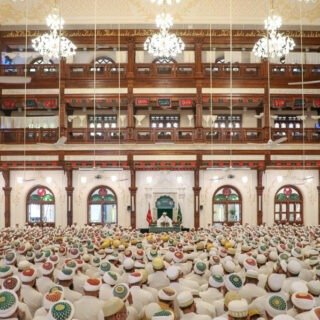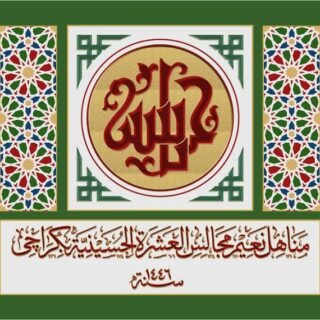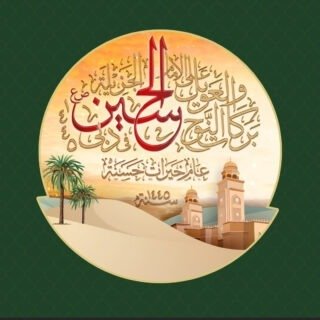Reflections
Like previous occasions this year, Mumineen were fortunate to obtain the barakat of three Duat Mutlaqeen AS in this waʿz mubarak on the auspicious occasion of the milad mubarak of Imam al-Zaman AS. The 4th of Rabi al-Aakhar is the date of the birth of Maulana Imam Al-Tayyib AS, the 21st Imam and it serves as the continued date of celebrating the milad of Imam al-Zaman AS throughout this period of satr. As it was explained in the waaz mubarak, each Imam of the satr period is referred to by the name al-Tayyib and the Duʿat Mutlaqeen AS are engaged in the tasbeeh of this name day and night.
Maulana al-Imam al-Tayyib AS shares the lofty virtues and stature of Rasul Allah SAW as well as his kunya: Abu al-Qasim. Also his reign spanned two ages, one of kashf, (revelation) and the other of satr (concealment). Al-Dai al-Ajal Syedna Taher Saifuddin RA explains that al-Imam al-Tayyib’s AS birth took place in the time of his father, Maulana al-Imam al-Amir AS, who was the last of the Imams of zuhur. Following his martyrdom, the 21st Imam chose satr, thereby making him the first of the Imams of this period.
Al-Dai al-Ajal Syedna Taher Saifuddin RA states in verse:
Al-Tayyib, the pure, the fragrant, personage
Of two eras: revelation and concealment.
Yet even this period of satr is characterized by the manifest qualities of kashf by the efforts of the Duʿat Mutlaqeen AS who convey the knowledge of absolute truth, haqaaʾiq, to Mumineen.
The Imams are divided into septets of which Imam Tayyib AS is the last of the third. Thereafter the fourth septet is named ‘Al-Abdaal’. While the Imam will change as one passes and another takes his place, he will always be known as ‘Al-Tayyib’.
Al-Dai al-Ajal Syedna Taher Saifuddin RA spoke about the Sijill al-Bisharat (Letter of Glad Tidings), a sijil being a letter of executive order. There is one word from it that Syedna RA determined to have been ‘al-mandal’ as recorded in the History of Yemen compiled by a renowned historian Najmuddin Abu Mohammed Umara bin Abi al-Hasan who lived in the latter part of the Fatimi empire in the 6th century Hijri (12th century CE). The word ‘al-mandal’, which features in his version of the Sijil, is appropriate and means agar – the fragrant wood, as opposed to ‘sandal’, which appears in other references to the sijjil and means sandalwood. Syedna Saifuddin RA explained that the fragrance of agar is far more potent than that of sandal and therefore must have been the intended word in the Sijil.
Al-Imam al-Amir AS had presaged his own martyrdom by taking a dagger and plunging it into a watermelon whilst stating, in plain sight and hearing of all those in his court, ‘The miskeen (pauper), son of a miskeen, killed by a dagger!’
Al-Imam al-Tayyib’s AS birth was a momentous occasion celebrated with great pomp in the city. Al-Qahira was decorated, the inhabitants donned their finest clothes and celebrations lasted for 14 days. On the 14th day following his birth, the aqiqa ram was brought garbed in a rich cloth, garlanded with a necklace of silver and slain in the presence of the Imam. The palace was filled with the fragrant scent of fruits, amber and oudh.
On the auspicious occasion of al-Dai al-Ajal Syedna Mohammed Burhanuddin’s ʿurs mubarak this year, al-Dai al-Ajal Syedna Mufaddal Saifuddin TUS presided over a waʿz majlis in Saifee Mahal’s second floor hall. It is a matter of immense fortune that on the night of Milad Imam al-Zaman AS we received the barakaat of this waʿz mubarak in which Syedna al-Dai al-Ajal TUS narrated in great detail the events that preceded Rasul Allah’s SAW advent as a Prophet and wedding with Maulatona Khadija AS.
Syedna al-Qadi al-Numan RA narrates that when the time of Maulana Abdul Muttalib’s AS passing neared, he gathered his ten sons and six daughters and inquired of them as to who would look after Nabi Mohammed SAW as he had. Maulana Abu Talib AS took on the responsibility and vowed to protect and nurture Rasul Allah SAW.
At a young age, Maulana Abu Talib AS asked Nabi Mohammed SAW if he wished to join him on a trading expedition to Busra so that he may teach him the intricacies of trade, the art of knowing and perceiving the qualities of men and the customs and cultures of travel. Syedna Saifuddin TUS pointed out that Busra is located in Syria and should not be confused with Basra in Iraq. It was to Busra in Syria that the Quraish travelled to each year for trade. Nabi Mohammed SAW agreed to accompany Mualana Abu Talib AS on his journey.
It was the custom of the Arab trade caravans to sojourn at the monastery of Buhaira al-Rahib who would host them for the three days of their stay. Buhaira was a man of knowledge. He keenly anticipated the coming of a new prophet as was foretold. When he saw Nabi Mohammed SAW and the piety of his ways, that he did not partake with the rest of the Quraish in their drinking and poetic merriment, he asked Rasul Allah SAW why he chose to abstain from these activities. Rasul Allah SAW replied that he was not a poet and that he observed that those who consume alcohol forfeit their intellect. Buhaira became convinced that he was indeed the awaited nabi and exhorted Maulana Abu Talib AS not to take him to Busra as it was a stronghold for his foes who wished him harm. He requested him to either leave Rasul Allah SAW in his care until Abu Talib AS returned or to send Nabi Mohammed SAW back to Makkah. Maulana Abu Talib AS chose to send him back to Makkah.
At the age of 24 Mohammed SAW once came to Maulana Abu Talib AS and found him in a state of sorrow, tears streaking down his cheeks. He asked Maulana Abu Talib AS what the matter was to which he replied that it was out of concern for Rasul Allah SAW that he wept. He informed Rasul Allah SAW that Maulatona Khadija AS was accustomed to sending traders on her behalf each year and that her ventures always proved profitable. Although Maulana Abu Talib AS was concerned about the safety of Nabi Mohammed SAW he urged him to take up the responsibility of Maulatona Khadija’s AS trading expedition so that Maulana Abu Talib AS would have the opportunity to build him a house and make preparations for his marriage. Nabi Mohammed SAW agreed and when Maulatona Khadija AS was informed of his decision she sent Maisara, her chief servant, to accompany Rasul Allah SAW on his journey and instructed him to heed his every command.
As the caravan proceeded through Tihama, they were faced with intense heat and winds. At that moment a white cloud appeared and took Rasul Allah SAW under its shadow, and by virtue of him the entire caravan.
Nabi Mohammed SAW joined the trading caravans with 8,080 dirhams in his possession and a consignment of goods laden on 40 camels. As they set out on their journey, the caravans came across a desolate wadi from where they turned their direction in order to avoid the wadi altogether. Rasul Allah SAW asked why they had chosen to avoid the wadi and was informed that it was inhabited by a dangerous snake of enormous proportions prone to attacking and devouring their mounts. Rasul Allah SAW dismounted stating that bravery was a virtue held by Allah in high esteem. Taking his staff in hand, he entered the wadi on foot all the while praying to Allah Taʿala to provide safe passage for the caravan if the snake was muslima or to give him the strength to triumph over it if it was a kafira. As Rasul Allah SAW proceeded, someone alerted him to the snake approaching him from behind. He lunged at the snake with his staff and severed it in two. The Quraish were left astonished by his bravery.
As the caravan proceeded, they came to Buhaira’s monastery as was their custom. Buhaira noticed that a white cloud shadowed the caravan wherever they went. In order to ascertain who in particular the cloud was shadowing, Buhaira only slightly opened the doors to his monastery forcing everyone to enter one at a time. As each person entered, Buhaira enquired as to who they were. The cloud, however, remained outside where it was hovering over the Nabi Mohammed SAW who, for the sake of his honesty and trustworthiness, had been selected to watch over the entire caravan’s goods. Buhaira requested that the Nabi Mohammed SAW join the rest of them and assured the Quraish of the safety of their goods and that he would be liable for any damage should it occur. As Rasul Allah SAW entered, Buhaira saw that the cloud followed him coming to rest atop the monastery once the Nabi SAW had entered. He asked Rasul Allah SAW if he was still true to his eschewal of drink and poetry and was struck by the vision of Mohammed’s SAW magnificent grace and otherworldly demeanour.
While Nabi Mohammed SAW and the Quraish were still at Buhaira’s monastery, a delegation of seven yahudi priests travelled from Busra to meet with Buhaira. They had come in search of the one who was shaded by the cloud for it was foretold in their scriptures that he would be the one to wage war upon them and establish his religion above all others. They informed Buhaira that a mob of 4000 had gathered outside Busra to prevent him from entering. Buhaira spoke to the priests and made them realise that Rasul Allah SAW was indeed the Nabi of Allah and that his coming was not something to be feared but to be welcomed as it was the Nabi Mohammed SAW who was the ultimate nabi mentioned in all the scriptures left behind by past Prophets. He added that on the Day of Qiyamat, Rasul Allah SAW will intercede before the Almighty on behalf of all communities and faiths and grant them his shafāʿt. The seven priests saw the truth in what Buhaira said and they came to Nabi Mohammed SAW pledging him their allegiance. The priests went back to Busra and dispersed the assembly by assuring them that they had nothing to fear and the matter was not as they thought it to be.
The caravan finally reached Busra and the Quraish set up their stalls in the marketplace. For five days they traded and made a profit of ten dirhams on every dirham. On the sixth day as Rasul Allah SAW and Maisara took stock, they noticed that one consignment of goods was left unsold. A one-eyed soothsayer passed by and inquired about the price of the goods. Nabi Mohammed SAW replied that he would sell them to him for 10 mithqals, however, the soothsayer countered with an offer of 7. Rasul Allah SAW said that he would accept no less than 8. As Rasul Allah SAW began to weigh, the soothsayer started to circle him and as he passed behind the Nabi SAW, he saw the mark of nubuwwat between his shoulders as his shroud had momentarily slipped. As was agreed, Nabi Mohammed SAW presented the goods accordingly in exchange for 8 mithqals of gold but the soothsayer wrongly claimed that they had agreed on 7. He asked Mohammed SAW to swear by Laat and Uzza (the names of two pre-Islamic idols) that they had not agreed on 7 and Rasul Allah SAW strongly retorted that Laat and Uuzza held no significance for him. The soothsayer knew that Rasul Allah SAW was indeed the one they sought and raised an alarm to alert the mob to his presence. As the mob thronged to the marketplace the Quraish positioned themselves in a line of defense in front of Nabi Mohammed SAW. Maisara suggested that he and Prophet Mohammed SAW should use the cover provided by the Quraish to leave Busra thereby preventing a battle and bloodshed. Rasul Allah SAW agreed and they left Busra.
Maulatona Khadija AS had perched herself upon Jabal Abi Qubais for days in anticipation of Nabi Mohammed’s SAW return. The height of the mountain provided a far-reaching view of the road from Busra and enabled her to spot the caravans well in advance of their return to Makkah. Rasul Allah SAW came ahead of the caravans to inform Maulatona Khadija AS of the successful venture which had yielded a profit of twenty dirhams on every dirham. Maulatona Khadija AS was pleased and said that she would give Nabi Mohammed SAW three camel calves instead of two and asked him SAW to go back and join the caravans to accompany them as they arrived in Makkah. Later, Rasul Allah SAW mentioned that he would use one camel for his wedding expenses, the second for the walima, wedding meal, and the third to further his cause.
Maulatona Khadija AS came to the Prophet Mohammed SAW and made him aware of her interest in marrying him. Rasul Allah SAW came to Maulana Abu Talib AS to ask for his permission and blessing. Maulana Abu Talib AS and Maulana Hamza AS were both pleased at the prospect of Nabi Mohammmed’s SAW marriage to Maulatona Khadija AS and accompanied Rasul Allah SAW to Khuwaylid, her father’s house to ask for her hand. Maulatona Khadija’s AS father gladly accepted and was given 300 dirhams and two Yemeni shawls as mehr. Maulana Abu Talib AS then presided over the nikah majlis and the two were married. Maulana Abu Talib AS commenced the nikah khutba with the bismillah, the first ever instance of it being recited, and during the khutbah, which took place before Nabi Mohammed SAW was bestowed with nubuwwat, he took his name as Mohammed Rasul Allah.
Syedna Aali Qadr Maula TUS recited the shahadat of Imam Husain AS, first recalling that all of the Panjatan remembered him at their passing. Syedna al-Dai al-Ajal TUS read from the words of Syedna Abdulqadir Najmuddin RA of an instance when the young Imam came before his grandfather with dust covering his face. Rasul Allah SAW went to kiss his beloved grandson but out of respect for Nabi Mohammed SAW, Imam Husain AS did not let him due to his current state. Rasul Allah SAW sought to wash off the dust when he was beckoned from above not to hurry. Jibraʾeel descended with the heavenly water of Salsabeel. As Rasul Allah SAW washed away the dust with his own hands Jibraʾeel, watching on, began to cry as he recalled the events of Karbala. Rasul Allah SAW remained unaware of his mourning until his tears fell upon Rasul Allah’s SAW face Seeing Jibraʾeel in this state, Rasul Allah SAW embraced him. Jibraʾeel then related what torment would befall the illustrious head of his cherished grandson. The harrowing account caused Rasul Allah SAW to collapse and faint and when he came around Imam Husain AS enquired why he had suddenly lost consciousness. Rasul Allah SAW recounted what Jibraʾeel had just told him. Imam Husain AS asked why this saddened him, when he himself was glad to hear it since martyrs are forever alive? But he did have one request, that Rasul Allah AS not reveal any of this to his father, nor his mother nor his brother for it would cause them immense grief.
Syedna Taher Saifuddin RA spoke of Amirul Mumineen’s AS two sajdas, one in Bait Allah and the other in the mihrab of Kufa’s masjid. Imam Husain AS also gave two sajdas, one when he was born and the second in Karbala.
May Allah Taʿala grant Syedna al-Dai al-Ajal TUS a long life in pristine health until the Day of Qiyamat.
www.jameasaifiyah.edu








